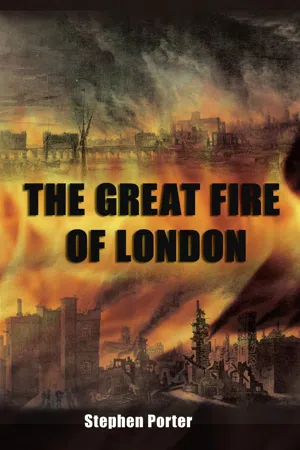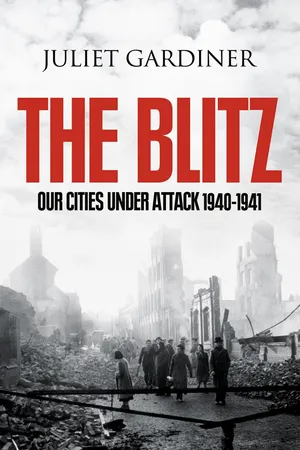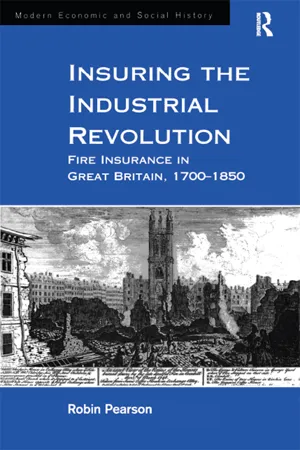History
Great Fire of London
The Great Fire of London was a major conflagration that swept through the central parts of the English city of London in 1666. The fire destroyed a large portion of the city, including thousands of homes and important buildings such as St. Paul's Cathedral. The event led to significant changes in urban planning and building regulations to prevent future fires.
Written by Perlego with AI-assistance
Related key terms
Related key terms
1 of 4
Related key terms
1 of 3
5 Key excerpts on "Great Fire of London"
- eBook - ePub
- Stephen Porter(Author)
- 2011(Publication Date)
- The History Press(Publisher)
This, too, may have struck a chord with contemporaries, for fire-fighters who took it upon themselves to pull down buildings to create a fire-break and so check the progress of the flames were liable to find themselves taken to court by the owners of the property and compelled to pay the cost of rebuilding. Many readers would also have been aware of the parallel between the fate narrowly escaped by the imperial palace in Lilliput, which had ‘cost so many ages in erecting’, and that of Whitehall Palace, part of which was gutted in a blaze in 1691 and the whole of the remainder, except for Inigo Jones’s Banqueting House, by a fire in 1698. Gulliver’s adventure must also have brought to mind the Great Fire of London of 1666, only sixty years before the publication of Gulliver’s Travels, when Sir Thomas Bludworth, the lord mayor, called to the early stages of the fire, was said to have remarked that ‘a woman might piss it out’. 1 The conflagration that developed from the fire which Bludworth treated so dismissively was London’s greatest single disaster and has come to be regarded as one of the major landmarks in English history, ranking in popular awareness with events of national importance such as the defeat of the Spanish Armada in 1588. It was all the more devastating because it came as the city was recovering from a severe outbreak of plague in the previous year, which, with high mortality levels from other diseases, had claimed almost 100,000 lives, nearly six times the normal death rate. There is something poignant in the fact that these two calamities came so closely together, and they have tended to be associated. Yet there were important distinctions between an epidemic and a conflagration. The most obvious one was that an epidemic brought death, and fire physical destruction, and so they affected the urban community in quite different ways. Their social impact also varied - eBook - ePub
The Eighteenth-Century Town
A Reader in English Urban History 1688-1820
- Peter Borsay(Author)
- 2014(Publication Date)
- Routledge(Publisher)
In London 13 200 houses were destroyed by the Great Fire of 1666, a large proportion having been wholly or mainly of wood. In their stead over 9000 standardized brick houses were erected (Buer, 1926, p. 78: Reddaway, 1951, p. 129). The Great Fire was not, however, the end of destruction in London by fires. There were serious outbreaks in eighteenth-century London, one at Change Alley in 1748, which burned 118 houses (Ash, 1964, p. 93). Much of eastern, unfashionable, workaday London escaped regulation even after 1666 and remained crowded with timber houses, of which still more were actually put up. Only from the mid-1780s were these substantially replaced by brick, and often then only when fire had made the opportunity, the biggest single chance coming in 1794 when over 600 houses in the East End were destroyed by a fire (George, 1966, p. 346). But the City and western districts of London were never again so devastated after the time of the Great Fire. Many smaller towns were less fortunate: East Dereham (Norfolk), 1679; Newmarket (Suffolk), 1683; New Alresford (Hampshire), 1689; Warwick, 1694; Woburn (Bedfordshire) and Buckingham, 1725; Blandford Forum (Dorset), 1731; and Tiverton (Devon), as late as 1794 were among those severely burned, some almost totally leveled. There were several towns that suffered two or three or even up to ten or twelve major conflagrations between the Restoration and the beginning of the nineteenth century, including Tiverton as an extreme case. Such towns were, however, exceptional in continuing to suffer the high fire incidence of earlier centuries.So frequent had fires been in the Middle Ages that some leases contained the phrase ‘usque ad primam combustionem’ since landlords wished to be able to recover the building plot from any tenant who might not be able to afford to rebuild after a fire or keep up the rent (Stacpoole, 1972, p. 257). Thatched roofs mixed unhappily with the naked flames used for lighting and heating and the open fires for manufacturing or processing tasks carried on in the middle of towns. Medieval corporations tried, and their successors tried, to banish crafts that used open fires, such as smithery, pottery making, dyeing, tanning, tallow chandling, and malting. The workshops of these trades were all too often the origin of serious fires. At Andover, Hampshire, in 1668, the tanners were ordered to shift their kilns to the riverside ‘and sufficiently tile them’ because it had been found ‘by sad experience’ that they had several times nearly set the whole town on fire (Child, 1972, p. 23). Regulations of this kind lapsed as often as they were promulgated, for business premises and dwellings remained one and the same and new businesses were constantly starting up inside the towns. Further, it was impossible to cut the fire risk drastically when open fires were needed for domestic heating and cooking and when stacks of hay and straw and firewood continued to be stored close to every house. Given that the materials of the buildings themselves remained highly combustible, no mere administrative or legislative action could be wholly effective in preventing the outbreak and spread of fires. - eBook - ePub
The Blitz
The British Under Attack
- Juliet Gardiner(Author)
- 2010(Publication Date)
- HarperPress(Publisher)
On 29 December the Thames was at an abnormally low ebb as the raid began. Though fireboats pulled as near as they could to the shore, the firemen found it impossible to get their suction pipes through the mud and into the water mid-stream. Falling bombs fractured water mains, and soon the hydrants were running dry. With the static water tanks empty, the firemen struggled desperately to fight the terrible conflagration with little more than a dribble of water issuing from their hoses. Embers and incandescent particles swirled in the air, pricking the faces of the firefighters and igniting more fires. Buildings crashed to the ground, blocking the narrow City streets and making it impossible for the fire and Civil Defence services to get through. To add to the odds stacked against those fighting the inferno, a strong westerly wind blew through the streets, whipping the flames to a greater frenzy.It seemed as if the City was doomed. Like a tragic replay of the Great Fire of London of 1666, its greatest buildings were destroyed, hundreds of years of history and tradition reduced to rubble and charred wood. ‘On Sunday night, as I was reading about the Great Fire, in a very accurate detailed book,’ Virginia Woolf wrote in her diary on the first day of 1941, ‘London was burning. 8 of my city churches destroyed, & the Guildhall.’The numerous fires soon joined together to form two mighty conflagrations, the worst of which ravaged half a square mile between Moorgate, Aldersgate, Cannon Street and Old Street. Fire Brigade control centres had twice to be abandoned – on one occasion staff clutching vital papers fled to safety through a network of underground tunnels. In the Operations Room at Redcross Street Fire Station in the middle of the Barbican, the heat was so intense that Aylmer Firebrace, Chief Fire Officer for the Greater London Region, noticed the paint blistering on the walls while the telephonists tried to work by candlelight (though the light from the fires outside made that superfluous) as one by one their phones went dead. Suddenly a Civil Defence warden rushed in, shouting, ‘Your bloody roof’s alight!’ - eBook - ePub
Charles II's Favourite Mistress
Pretty, Witty Nell Gwyn
- Sarah-Beth Watkins(Author)
- 2021(Publication Date)
- Pen and Sword History(Publisher)
While the city tried to get back to normal, the Anglo-Dutch War was continuing. At the beginning of June a ferocious and devastating four-day naval battle took place. The English fleet of fifty-six ships under the command of General Monck was outnumbered by an eighty-four strong Dutch fleet with superior guns. Thousands of Englishmen lost their lives. Eight ships were sunk with nine more captured. It was a humiliating defeat with many losses of men and young boys. Some died in battle and many more returned wounded or were taken prisoner.War was an expensive business and one that the Crown could not sustain. Ships were destroyed, others needed repair and the sailors wanted their wages, but the King was low on funds. England could not afford to lose more men’s lives, but at another skirmish on St James Day 300 Englishmen died. The Dutch, however, lost in the region of 5,000 men and for now it put an end to more hostilities. The wounded and broken returned home and walked the streets of London. Nell’s heart went out to them and the plight of the soldiers would forever stay in her mind.One of the most devastating events to affect London was yet to occur. In the early hours of 2 September, as people lay sleeping, cries of ‘Fire! Fire!’ rang out. In a city of wooden houses, it wasn’t unusual for the peace to be broken by such a call of alarm and many rolled over in their beds and pulled the blankets tighter. This fire, however, would be the greatest conflagration to sweep across the city. Initially it started at a bake house close to Pudding Lane, near London Bridge, but it wasn’t thought to be especially high risk. The Lord Mayor, Sir Thomas Bludworth, declared that ‘a woman might piss it out’2 but he was so terribly wrong.Fanned by an easterly wind, the fire spread to adjoining houses. As people finally realised the risk and hurried from their beds, it grew out of control, fed by the tar and pitch that was stored in riverside warehouses. As the sun rose, people could see London Bridge was aflame. A gap between the buildings stopped it from spreading south and instead it spread eastwards, marching through the city and destroying all in its wake. People fled for their lives as the flames grew higher. Gathering up their children and their belongings and carrying what they could, they ran. Some tried to hastily bury their valued possessions or hide them but the flames moved too quickly, urging them on. - eBook - ePub
Insuring the Industrial Revolution
Fire Insurance in Great Britain, 1700–1850
- Robin Pearson(Author)
- 2017(Publication Date)
- Routledge(Publisher)
11As Thomas has pointed out, Protestantism taught men and women to try such methods of self help in the face of calamities, before invoking supernatural aid. From this developed a ‘nascent statistical sense’, an awareness of patterns in apparently random behaviour.12 The search for quantifiable patterns in nature was reinforced by a burgeoning reportage. Bernstein has remarked that probability judgements are attached not to events but to descriptions of events. The more vivid and accurate the account, the greater the propensity to assign a probability value to the event described.13 The eyewitness reports of earthquakes, floods and fires, given wide publicity by a growing pamphlet and newspaper press from the late seventeenth century, drove these events into the popular consciousness, as well as raising awareness among the educated and propertied classes of the need for preventive or remedial action.The ideology of private property, whose primacy was acknowledged in the constitutional settlement of 1688, underlined this search for pattern and predictability, by emphasising the need to reduce uncertainty for the property- owning classes and to bolster the social order. The rise of humanitarianism was also a factor, for efforts at fire prevention can be seen as part of a wider movement which included projects for reviving victims of drowning accidents and suicide attempts, the building of hospitals and dispensaries, and schemes for rescuing destitute children and ‘penitent’ prostitutes.14 Fire, of course, frequently provided a tool for individual vengeance, a means of collective social protest, and a vehicle for social discipline. Arson had long been associated with malevolent spirits, most notably witches, and with society’s marginal groups, vagrants, beggars, and the economically and politically disaffected. Deliberate fires were commonly started by burglars and aggrieved employees.15 During the second half of the eighteenth century the incidence of arson rose in conjunction with growing labour unrest, especially during wartime, and there was a tangible increase in the sense of the threat to property, which made the search for protection from fire more urgent. Indeed, it has been suggested that one of the characteristic institutions of this period, the associations for prosecuting felons, may have helped spread the fire insurance habit in their local areas.16
Index pages curate the most relevant extracts from our library of academic textbooks. They’ve been created using an in-house natural language model (NLM), each adding context and meaning to key research topics.
Explore more topic indexes
Explore more topic indexes
1 of 6
Explore more topic indexes
1 of 4




